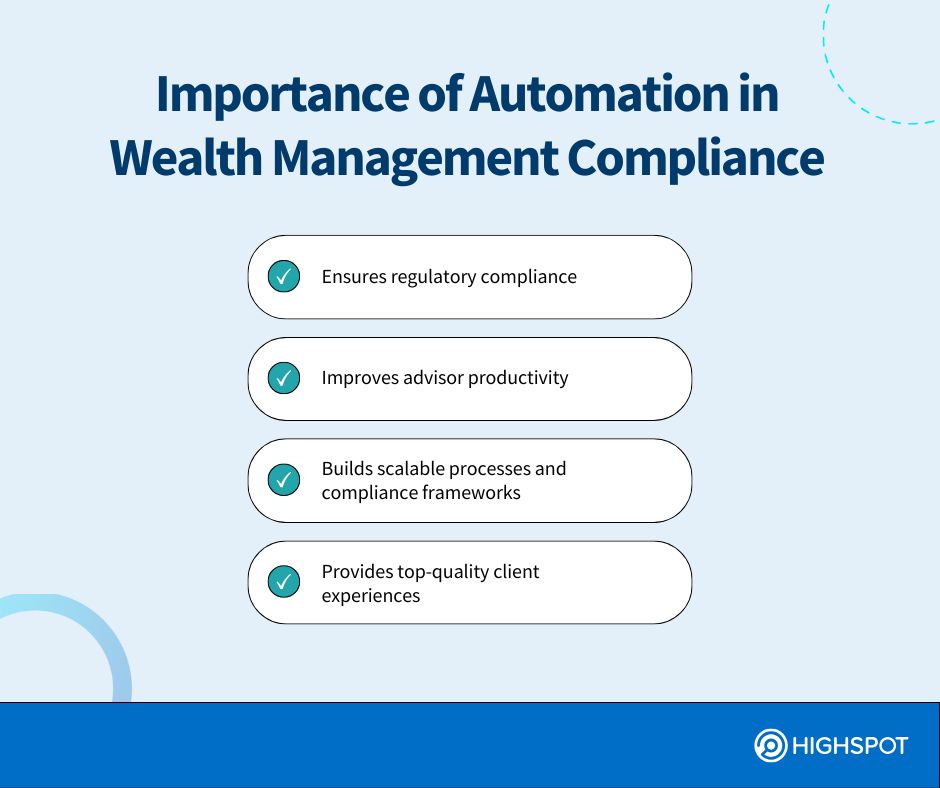Key Takeaways
- Automation in wealth management involves using artificial intelligence (AI), machine learning, and robotic process automation (RPA) to handle repetitive tasks and manage data efficiently.
- Automating tasks like client onboarding and compliance monitoring allows wealth management firms to reduce errors and focus on building stronger client relationships.
- By 2026, 90% of finance functions will use at least one AI-enabled solution.
Many wealth management leaders face mounting compliance requirements, the constant need to safeguard client data, and the pressure to deliver higher returns. On top of that, they must excel at their day-to-day jobs—portfolio performance, client engagement, and tailored investment advice.
These challenges already feel overwhelming, especially as outdated processes fail to meet clients’ evolving expectations. Consider a wealth management firm stuck with outdated, paper-based workflows. Manual processes delay client onboarding and risk data breaches from poor document handling.
Thankfully, automation is increasingly adopted across the financial sector today, simplifying these challenges and helping firms thrive in a competitive market. By improving wealth manager workflows, automation prepares asset management firms for audits, strengthens data security with digital storage, and enables top-tier client service that is still personalized.
In this article, we will explore wealth management automation, look at the difference automation can make, and present six steps to get started.
What is Automation in Wealth Management?
Automation in wealth management uses technology to handle simple tasks and manage data efficiently. Tools include robotic process automation (RPA), artificial intelligence (AI), and machine learning. These enable firms to use resources wisely, make better decisions, and respond quickly to client needs.
This intelligent automation can range from basic rule-based actions that populate forms to advanced AI algorithms that offer predictive analytics for portfolio management. For example, a wealth management firm might use AI-based customer relationship management (CRM) software to automatically categorize clients and validate their data from onboarding forms. Automation technologies flag potential gaps and compliance issues in real-time; that way, advisors can prioritize building relationships until the software notifies them to review missing documents or correct data entry errors.
Automation empowers wealth managers to focus on providing tailored investment advice and nurturing client relationships while significantly reducing manual errors. By automating routine processes, they can meet their clients’ evolving demands.
Why is Automation Essential for Wealth Management Compliance?
Manual compliance processes are slow and prone to errors. This increases regulatory risk and delays client service. Automation resolves these problems by helping wealth management firms manage the sales pipeline, meet deadlines, and provide smooth customer experiences.
Modernizing compliance workflows can be game-changing, especially for relationship managers (RMs). According to McKinsey, RMs spend 60% to 70% of their time on non-revenue-generating activities due to outdated systems, spreadsheets, and rising compliance obligations. As clients expect more remote engagement and digital access, it’s clear that these legacy practices need to evolve.
Automation offers several compliance-specific benefits:

Ensures Regulatory Compliance
Automated workflows help satisfy FINRA, SEC, and GDPR rules. These systems track approvals and flag incomplete submissions, reducing compliance bottlenecks. Automated record-keeping also provides quicker access to historical data during audits.
Improves Advisor Productivity
Compliance is necessary but shouldn’t consume the bulk of an advisor’s day. Automation takes care of time-consuming back-office paperwork, like data entry and document validation. This provides advisors more time to personalize investment strategies, understand client goals, and build trust. Client satisfaction and retention naturally improve when they focus more on creating meaningful interactions.
Builds Scalable Processes and Compliance Frameworks
Automated business processes can help firms adapt quickly to changing regulations or expansions by creating sustainable, repeatable processes. Whether you’re onboarding new advisors, entering a new market, or responding to law updates, automated systems ensure compliance processes stay seamless.
Provides Top-Quality Client Experiences
Clients expect smooth, professional experiences, especially through digital channels, and compliance should never get in the way. Automation ensures advisors can access the most up-to-date, pre-approved sales content and regulatory resources.
Take Osaic Wealth, for instance. With their success with centralized content management and AI-powered tools, advisors can always access the latest approved materials and make decisions faster. This consistency enabled Osaic to deliver accurate, timely, and personalized service, contributing to a 74% increase in win rates and a 95% boost in quota attainment.
Related Resource: The All-In-One Sales Content Management Toolkit
How Will AI Automation Transform Wealth Management?
AI automation is reshaping the way wealth management firms operate. It can enhance everything from risk management to highly personalized financial advice. PwC projects that asset management using AI-powered robo-advisors could reach nearly $6 trillion by 2027, almost double the amount in 2022. Additionally, Gartner predicts that by 2026, 90% of finance functions will use at least one AI-enabled solution, though fewer than 10% will see headcount reductions. This shows that AI will support, not replace, human expertise.
AI’s hybrid model balances the strengths of humans and machines. By thoughtfully integrating AI automation into workflows, finance leaders can amplify human capabilities while compensating for technology’s limitations. This collaboration improves business performance and reduces employee hesitancy.
Despite AI’s ability to emulate human performance, algorithms cannot match the unique capabilities of people in areas that require creativity and complex problem-solving.
For example, AI-driven predictive analytics can identify market trends and assess risk across client portfolios, enabling advisors to recommend data-informed investment opportunities. Chatbots and virtual assistants handle routine customer queries 24/7, streamlining service and freeing advisors to focus on high-value tasks like meeting with clients to discuss future investments.
The future is bright for everyone involved: the AI bot, the wealth advisor, and the customer. According to McKinsey, applying generative AI to customer care alone could boost productivity by 30% to 45% of current function costs, demonstrating its transformative impact. As these capabilities evolve, AI will empower wealth management companies to deliver smarter, faster, and more personalized services, driving client satisfaction and business growth.
Key Areas Where Wealth Management Automation Delivers Value
Automation benefits every stage of the wealth management process, from client onboarding to advanced portfolio monitoring. By implementing the right mix of technology, firms reduce manual work, improve regulatory readiness, and launch new services faster. This benefits both advisors and clients.
- Client onboarding: Automation leads to faster and more accurate investor onboarding. Many software tools handle anti-money laundering (AML), know your customer (KYC), consumer duty, and suitability checks—reducing the burden on advisors and providing clients with a smooth onboarding process.
- Compliance: Automated risk management tools help firms adhere to regulations like FINRA, SEC, and GDPR with fewer headaches. By integrating continuous monitoring, alerts can instantly detect suspicious activities or data anomalies, helping compliance teams act swiftly.
- Portfolio management: Real-time analytics optimize investment strategies and monitor portfolio performance. Automated dashboards can pull data from multiple sources, offering advisors a consolidated view of each client’s assets, liabilities, and risk exposure.
- Digitalizing paper-based data: Despite growing digital transformation, paper remains common in the wealth management industry. Optical character recognition (OCR) technology and document automation software can help scan, extract, classify, and verify data and place it into the appropriate system. This reduces administrative errors and accelerates tasks like account updates or compliance checks.
Manual vs. Automated Efficiency Improvements
Automation has the power to streamline tedious, manual tasks and improve accuracy. Let’s examine some examples of how it can make a real difference.
| Task | Manual Process | Automated Process | Improvement |
|---|---|---|---|
| Onboarding, including client profiling | It takes weeks, prone to errors | It takes hours or days with real-time validation | Time and cost savings |
| Compliance monitoring | Manual review of transactions | Automated transaction scanning | Faster risk detection |
| Portfolio management | Delayed due to scattered data | Real-time consolidated insights | Faster data analysis and decision-making |
| Record digitization | High error rates, storage costs | OCR with instant access | Fewer errors |
6 Steps to Automate Your Wealth Management Operations
Starting an automation project can feel overwhelming, but with the right plan, it becomes manageable and rewarding. Here are six steps to automate wealth management operations:
1. Create an Automation Plan
Decide which tasks will be automated, who will be involved, and what KPIs you will track. Assess potential risks and how automation may impact your current workflows or staffing.
You should also consider your organization’s current capabilities and resources. For example, are you working with legacy systems that might need upgrading? Your plan should address today’s needs and anticipate future growth and challenges.
2. Evaluate Current Processes
Find opportunities for automation. Map out current workflows and pinpoint inefficiencies and bottlenecks, such as the manual data extraction from client statements. Consider where automation tools can reduce these redundant, time-consuming tasks.
You may also gather insights from your team, as they often have a frontline view of inefficiencies and can provide valuable feedback on where automation could help the most. Remember, the goal isn’t to automate everything but to focus on areas where the impact will be most significant.
3. Select the Right Tools
Now that you know your needs, look for platforms that can automate routine tasks in portfolio management, compliance monitoring, or CRM. You may also consider tools that enhance sales enablement for financial services. These can automate lead nurturing, streamline client communication, and provide actionable insights to improve conversion rates and strengthen relationships.
Talk to vendors and their current customers, review case studies, and request proof-of-concept (POC) for complex implementations. Evaluate how well each tool aligns with your requirements and ensure it works seamlessly with your existing tech stack.
4. Implement Solution
Collaborate with the vendor to form a structured implementation plan. You must understand how much time and effort your team will need to put forward. Do you need development resources? What sort of technical and leadership time will be required? Establish timelines, milestones, and success metrics, ensuring all stakeholders understand their roles. It may be beneficial to introduce automation in phases, starting with client onboarding and gradually expanding to compliance checks and portfolio management.
5. Train Staff
Offer vendor-led or in-house training sessions tailored to different roles to guide employees through the new system. Portfolio managers might need deep dives into analytics dashboards, while support staff may need workflow training.
Highlight automation’s benefits to gain buy-in. Show how these tools can reduce workloads, minimize stress, and free time for strategic tasks. Create user guides in an AI-powered enablement platform and offer ongoing support to help staff feel confident navigating the new systems.
6. Set Measurable Objectives
Track metrics like error rates, output volume, sales productivity gains, advisor capacity, and onboarding times to ensure you obtain the maximum ROI from automation. Review these KPIs regularly to identify improvement opportunities.
Lead the Way in Wealth Management with Automation
Now is the time for financial advisors to stand out by offering personalized products and services to all clients, tech-savvy or not, while keeping costs low. This adds pressure to move beyond outdated paper-based systems while maintaining rigorous security and compliance standards. Fortunately, new, innovative technologies like AI offer powerful solutions to minimize risk, improve accuracy, reduce costs, and satisfy customers.
Highspot is key to improving your internal processes and client experiences. Features like centralized content governance, scalable compliance frameworks, and advanced collaboration tools empower advisors to work more efficiently while delivering consistent, high-quality service.
Request a Highspot demo today.




